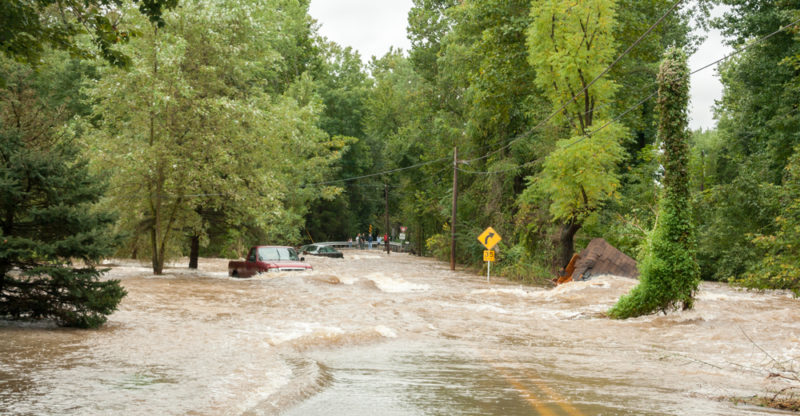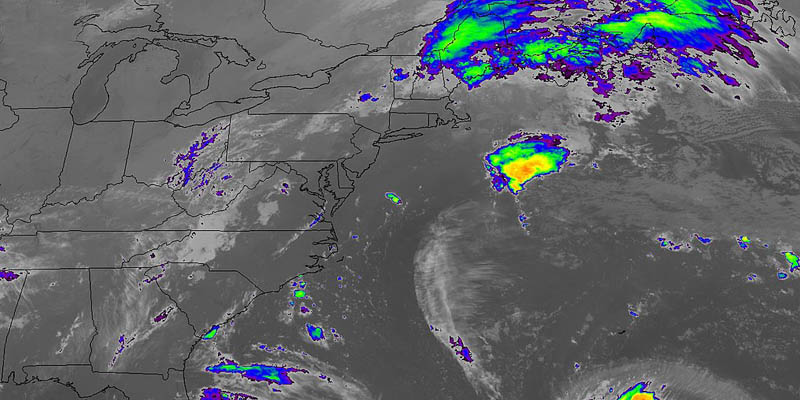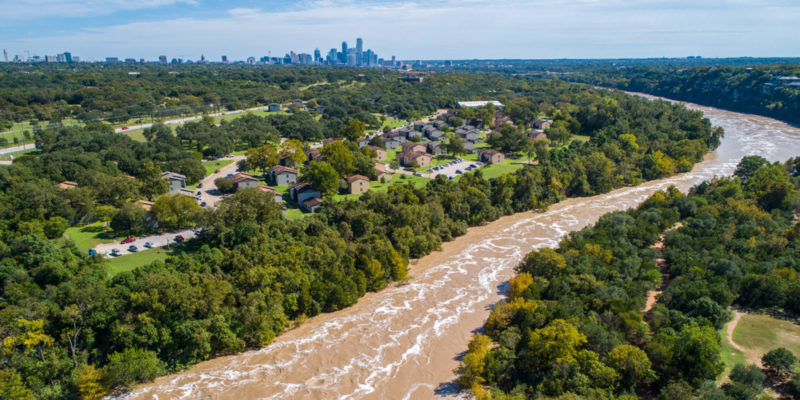We explain what floods are, and explore their causes and effects. In addition, we discuss their characteristics and types, and provide examples.

What is a flood?
A flood is an overflow or accumulation of water in an area that is normally dry. Floods are multicausal phenomena, which means they may be caused by a number of combined causes.
When floods occur, water may cover vast expanses of land, affecting people, animals, infrastructure, homes, and crops. Furthermore, they can lead to landslides damaging roads and bridges.
In urban areas, floods often result in costly property damage and may cause the loss of human life.
- See also: Drought
Causes of flood

The causes of floods may be natural or human. Among the main natural causes are:
- Excessive rainfall. Floods may occur following several days of rain. In these cases, the amount of precipitation exceeds the soil's absorption capacity or that of urban water systems, thus accumulating on the surface.
- Overflow of rivers and lakes. Floods may occur as a result of rising water levels in rivers and lakes due to heavy rainfall in a given area or in parts of its basin. They may also occur as a consequence of ice melt at the rivers' sources.
The main human causes of floods are:
- Urban expansion. The growth of urban areas makes soil impermeable, reducing its absorption capacity. In addition, urban settlements often occupy naturally flood-prone areas such as river or stream valleys.
- Soil sealing. The construction of new neighborhoods or the expansion of agricultural frontiers causes the soil to become compacted and sealed. When rainfall occurs, its absorption capacity is greatly reduced, which can worsen the effects of flooding.
- Artificial modifications of the terrain. In order to avoid floods, land is sometimes raised (embanked). While this has a positive effect on the elevated terrain, it significantly increases flood risk in nearby lowlands.
- Inefficiency of flood control works. Flood-prone cities often build hydraulic works to reduce negative effects. When not properly constructed or old, they become obsolete and do not serve their purpose.
- Broken dams or levees. When one of these constructions breaks, it causes a flash flood, as all the water contained in the reservoir is quickly released.
Being a multi-causal phenomenon, a flood is never the result of a single cause, but results from a combination of several factors. For example, floods may occur not only as a consequence of heavy rainfall or river overflow but also due to hydraulic works not properly constructed or obsolete, or soil sealing due to urban sprawl.
Effects of flood
The effects of floods vary according to their intensity and duration. Among the consequences of flood are:
- Destruction of crops and harvests. Floods can have a significant economic impact on rural producers due to the loss of crops ruined by excess water.
- Destruction of transportation routes. Floods may submerge roads and destroy bridges and other transportation infrastructure.
- Destruction of homes. Floods may damage or destroy homes. In the case of more precarious housing, water can sweep them away destroying them completely.
- Loss of human life and impact on health. Floods can be deadly and cause serious injuries, diseases, and psychological issues such as stress, depression, and anxiety.
- Interruption of public services. Floods often result in the disruption of electricity, potable water supply, and transportation services.
- Population displacement. Floods may force people to leave their homes or communities and migrate to other cities.
Types of floods

Floods can be classified according to their origin and characteristics:
- River floods. Caused by the overflow of rivers due to heavy rainfall or the thawing of headwaters. These floods can last several days or even weeks.
- Pluvial floods. Result from heavy and continuous rainfall, which leads to water accumulation on the surface because the soil cannot absorb it.
- Coastal flooding. Occur due to the rise in sea level. They may also be caused by natural phenomena such as hurricanes, typhoons, and cyclones.
- Dam or reservoir fracture floods. Caused by the failure or collapse of dams or reservoirs, resulting in the sudden release of large quantities of water.
Difference with waterlogging
Waterlogging occurs due to soil saturation and the accumulation of water on the ground. Soil saturation means it can no longer absorb more water, so any excess water accumulating in saturated soil will remain on the surface and will not be infiltrated into the soil.
When it has stopped raining, waterlogged areas may take many hours to dry out. The absorption capacity of soils usually recovers slowly, so waterlogged areas may continue to have surface water even several days after the event that caused the flooding has ended.
Soils may also become waterlogged without precipitation. Groundwater levels may at times rise to the surface flooding soils without there being a river overflow or heavy rainfall.
Flood prediction

A series of tools exist for predicting floods in advance. One such tool is the monitoring of rivers and streams, which allows for real-time measurement of their flow and levels. When an unusual change in any of the hydrological parameters takes place, the authorities are alerted so they can take preventive measures.
In addition, the weather bureaus in each country use satellite information to forecast the arrival of storms or extreme weather events that might cause flooding.
Science also contributes to flood prediction through simulation models that make it possible to anticipate the hydrological behavior of a region in the event of a storm or river flooding. This information enables authorities to make informed decisions when faced with this type of phenomena.
How to prevent floods
Water defenses such as reservoirs, barriers, walls, and drainage systems have been erected since ancient times to protect cities from rising sea levels and swollen rivers.
Accurate urban planning is essential in cities. It must take into account the construction of adequate infrastructure for flood control and the creation of green spaces to facilitate water infiltration.
Waste management is also important for flood prevention. Flooding often occurs because drainage systems are blocked by garbage, slowing down water drainage. Therefore, maintaining and ensuring the cleanliness of drainage systems is key.
The restoration and conservation of wetlands, rivers, and mangroves can help prevent floods, as these ecosystems act like natural sponges that retain and absorb water.
State regulation of urban development is also vital to prevent floods. Authorities must ensure that new constructions and neighborhoods are located in safe areas and comply with all appropriate drainage standards.
Flash flood

A flash flood is a type of sudden flood that occurs in a short period of time, usually within minutes or hours. These floods occur as a result of heavy rainfall in which a large amount of water falls in a short period of time.
Flash floods are especially dangerous because of their speed and intensity. Though they can occur anywhere, they are most common in mountainous areas, canyons, and streams. As they occur with little or no warning, it is extremely difficult to anticipate them, which makes them potentially very deadly.
A characteristic of flash floods is their ability to move large amounts of sediment and other materials, further increasing their danger. Additionally, strong water currents can sweep away vehicles, animals, and people, and cause significant damage to infrastructure like bridges and roads.
Floods in history
Some of the major floods in history include:
- The Mississippi River flood. It occurred in the United States in 1927. It flooded several states and resulted in over 400 deaths.
- The Yellow River flood. It took place in China in 1931. It covered more than 58,000 square miles (150,000 km2) and is estimated to have caused the deaths of over 2 million people.
- The Yangtze River flood. It happened in China in 1954. It affected over 69,000 square miles (180,000 km2) and resulted in more than 30,000 deaths.
References
- Ferrando, F. (2006). Sobre inundaciones y anegamientos. Revista de urbanismo, 15.
- Massa, A. (2018). China, 1931. Las crecidas más mortales de la historia. https://weather.com/
- Nunez, C (s.f). Qué son las inundaciones. https://www.nationalgeographic.es/
Explore next:
Was this information useful to you?
Yes NoThank you for visiting us :)